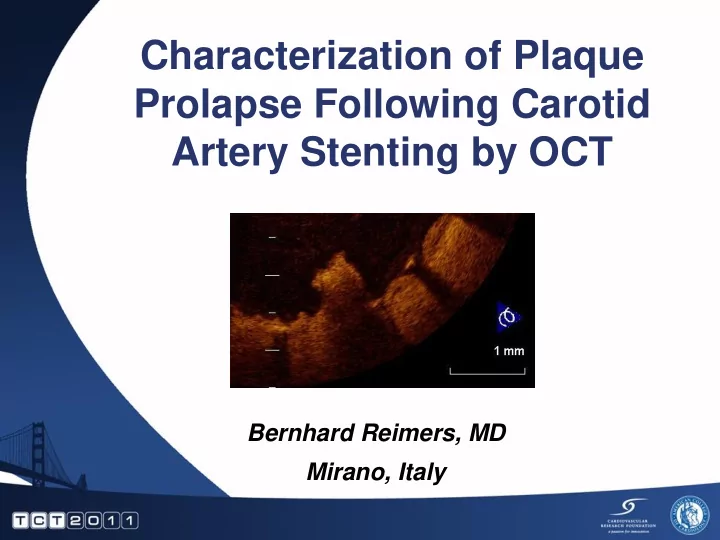

Characterization of Plaque Prolapse Following Carotid Artery Stenting by OCT Bernhard Reimers, MD Mirano, Italy
Disclosure Statement of Financial Interest I, Bernhard Reimers DO NOT have a financial interest/arrangement or affiliation with one or more organizations that could be perceived as a real or apparent conflict of interest in the context of the subject of this presentation.
Definition Plaque prolapse is defined as tissue extrusion through the stent struts post- procedure. Brack MJ, et al. Int J Cardiol. 1994;44(1):93- 95
Consequences of plaque prolapse Possible distal embolization Heart: From enzyme rise to heart attack Brain: From ischemic lesions to stroke
Relation between plaque components and plaque prolapse after DES implantation: virtual histology – intravascular ultrasound Hong YJ et al. Circ J 2010;74:1142 Necrotic core and fibrotic components were associated with development of PP; and both components in prolapsed plaque were associated with cardiac enzyme elevation after DES implantation. BMJ Case Reports 2009; Tsui, Lau
CEA & CAS have additional SPACE complications within 30 days Lancet 2006
DW MRI before and 5 days after CAS DESERVE Study
Cause of plaque prolapse Cheese grater effect of stents: - during deployment, - during postdilatation (most TCD hits), - during 30-days post procedure
Cheese grating is not always good Increased plaque prolapse from coronary experience: - thrombotic lesion - lipid core - thin cap over necrotic core Hung et al; Circ 2010 Differences between soft and hard cheeses plaques
Detection of plaque prolapse Angiography IVUS OCT In coronary arteries AHA Journals; BMJ; J Intevent Cardiol
The concept of plaque scaffolding of stents Closed-cell stents Open-cell stents Ø = 0.173 mm Ø = 0.128 mm NexStent Precise Ø = 0.107 mm Ø = 0.118 mm Acculink Xact
Emboli Protection Strategies and OCT acquisition Non Occlusive Technique
Emboli Protection Strategies and OCT acquisition Occlusive Technique
1 Positioning of OCT catheter distal to stent
2 Careful hand injection of 20cc dye (Ultravist 320) 3 When images ok: pull-back of OCT system
4 Hand re-aspiration of dye
Carotid OCT Post stent OCT After stent in stent with Acculink 6-8 x 40 mm and postdilatation with 5.5 x 20 a 12 atm balloon
Carotid OCT Small ulcers (no clinical determinant of complictions)
Carotid OCT Closed cell struts Open cell stent Open cell struts Closed cell stent
Carotid OCT Plaque rupture
Carotid OCT Flow artefact
Carotid OCT Plaque prolapse: Possible determinants of late complications
Carotid OCT before CAS
Lesion after stenting
Final result after post-dilatation
Conclusions (1) Conclusions OCT after carotid stenting appears feasible and safe. Using the occlusive technique, better quality images were obtained with the advantage not to increase the contrast load Carotid OCT allows collection of important information regarding the stent and plaque behaviour not seen with standard angiography Compared to IVUS less penetration (for plaque characterization), better surface images (for stent evaluation) Reimers et al.; EuroIntervention 2011
Coronary OCT Malapposition Prolapse Prolapse Dissection Prolapse Interv. Cardiol 2010;2:535
Recommend
More recommend